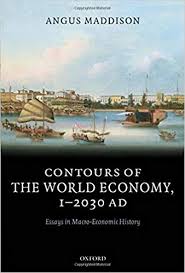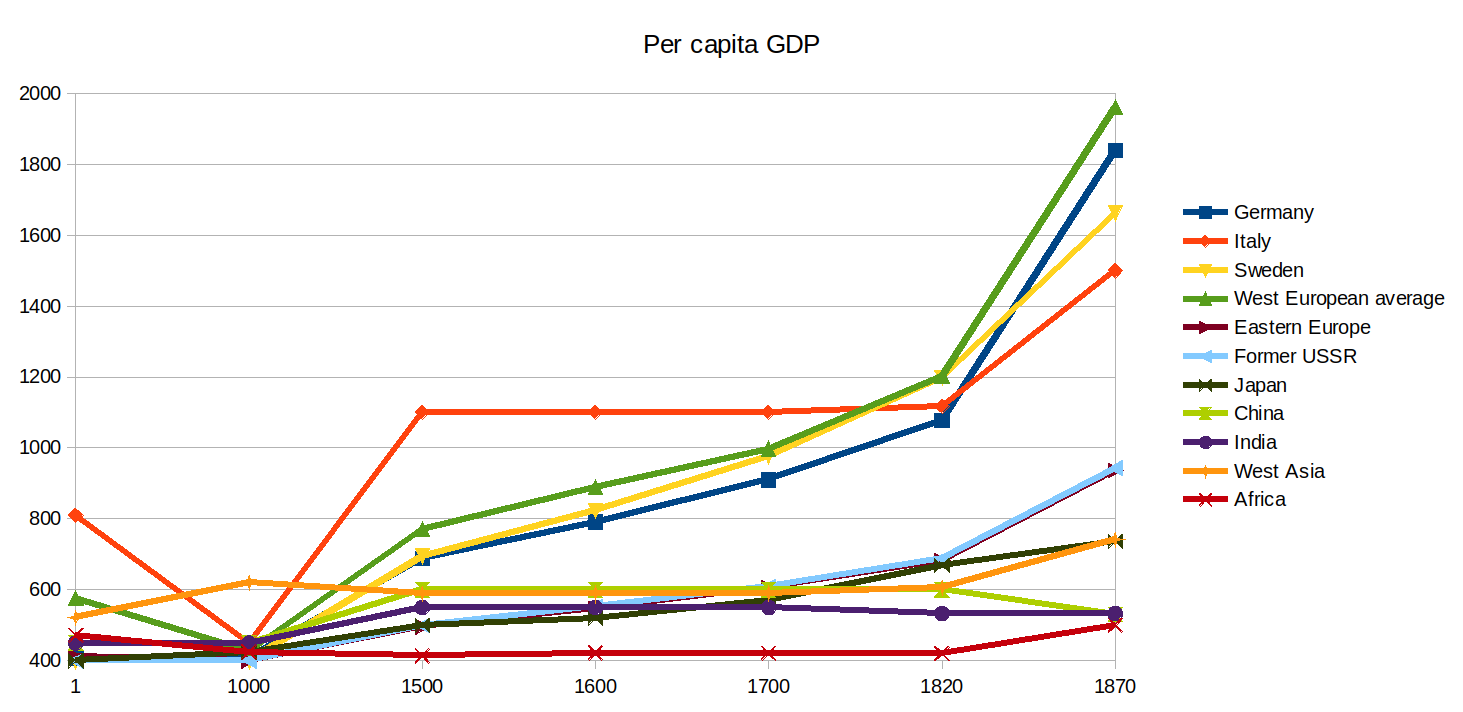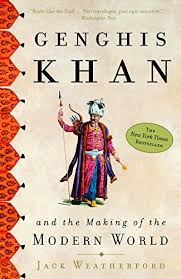 Angus Maddison’s Contours of the World Economy 1-2030 AD: Essays in Macro-Economic History is one of my favorite books (though if you are looking for economic history, Power and Plenty: Trade, War, and the World Economy in the Second Millennium is underrated/underread).
Angus Maddison’s Contours of the World Economy 1-2030 AD: Essays in Macro-Economic History is one of my favorite books (though if you are looking for economic history, Power and Plenty: Trade, War, and the World Economy in the Second Millennium is underrated/underread).
Maddison’s work is cited in this piece,
No, Mughals didn’t loot India. They made us rich: They remained as Indians, not colonists. Overall, I found it to be specious and sophistic in the details.
The specious part is the attempt to assert that India was rich during the Mughal period. The sophistic part was the interleaving of anecdata and observation to buttress the quantitative point, made with an appeal Maddison’s data set.
The reality is that it is likely that Maddison was wrong, and more importantly, the Mughal state was highly extractive:
There is more here. It is not my place to judge economic history, it’s not my specialty (though on the whole, I don’t dissent from the judgment of “Pseudoerasmus” on most things in his wheelhouse). And I still value Maddison’s magisterial work. And so should you.
The reason is simple: contrary to what Rana Safvi would have you believe, the vast majority of pre-modern people and societies were poor, with very marginal differences in per capita wealth in a modern sense. I am convinced by various arguments that large polities, such as the Roman Empire, can obtain some gains in efficiency through economies of scale, as well as reducing costs of production through imposing peace. But these differences were marginal compared to anything we moderns might believe to be worth notice.
To see what I mean, I’ve plotted some of Maddison’s data below:

According to Maddison, there was a decline in per capita wealth from the Mughal period to the early British period: from 550 to 533 dollars. First, this is hardly much at all. Second, it is clear that Maddison’s estimate here is very coarse, and we shouldn’t put that much stock in it.
But the bigger picture that I’m alluding too is clear when you look at all of Maddison’s data. 2,000 years ago Italy was the richest region of the world on a per capita basis (though since Madison is comparing a province of the Roman Empire to all of China, I think this is somewhat misleading). But Italy seems to have been only about twice as rich on a per capita basis as the poorest areas of the world. By 1500 the British Isles was already wealthier than India on a per capita basis, but it was only 1.3 times as wealthy.
When pre-modern observers, as quoted in the piece above, mention the wealth and riches of a polity, what they truly mean are the goods of the people of power. In 1500 France and the British Isles were at the same per capita wealth level. But the monarchy of France was much wealthier and more powerful than the monarchy of England. There were two reasons:
- The French monarch had a larger population from which they could extract taxes.
- The French monarchy engaged in a higher base rate of extraction from its subjects than the English monarchy.
According to economic historians, one way that the British closed the gap in later centuries was much better management of and recourse to public debt. The British “punched above their weight” in terms of mobilization of resources for this reason (eventually Britain surpassed France in population and per capita wealth).
But that’s neither here nor there. Observations of the wealth of the Mughals by European observers is mostly a function of the reality that the domains under Mughal control were extensive, and the Mughal Empire had a much larger population than any European state. Its wealth was not due to intensive production of economic vitality, as much as extensive exploitation of productivity. Similarly, the domains of the Chinese Emperors of the contemporary period allowed for lavish wealth, but that was due to the massive population increase in their territories in the centuries of peace.(part of this was due to the introduction of maize into lands where it was more suitable than rice or wheat).
Of course, there are differences between various political arrangements. Even before seeing the data on extraction levels above, I suspected that the Mughals were not necessarily encouraging economic flourishing in an atypical manner. The reason here is historical and ideological. Though the average per capita wealth of China across history did not vary a great deal, there were ideological variations which resulted in different levels of poverty and uncertainty. The orthodox Confucian Chinese view was rather libertarian and physiocratic. It emphasized low taxes on the farmers so as to encourage freeholding and rural prosperity. Though this was not always executed, it was the ideal. The pre-modern Chinese state as actually relatively “light.”
 One can think of a major exception here: the Yuan dynasty. That of the Mongols. Unlike the Manchus, the Mongols did not assimilate to Chinese norms. They engaged in massive extraction, pure rent-seeking, and brought in “middle-men minorities” (Central Asian Muslims often) to do much of the dirty work.
One can think of a major exception here: the Yuan dynasty. That of the Mongols. Unlike the Manchus, the Mongols did not assimilate to Chinese norms. They engaged in massive extraction, pure rent-seeking, and brought in “middle-men minorities” (Central Asian Muslims often) to do much of the dirty work.
On the whole, I believe that the Mongol influence on economic growth was predominantly negative in Eurasia during their period of dominance, because the steppe nomad ethos was extractive and predatory toward the ancient agrarian civilizations of Eurasia. The Pax Mongolica likely introduced some efficiencies through trade and the spread of ideas, but the local impact of Mongol rule in China, Persia, and Russia seems to have been one of predation and consumption, rather than fostering production.
The Mughals were in part descended from Mongols. And as Timurids they were patrons of culture but also adhered to the steppe ethos of extraction and predation. Rana Safvi emphasizes that the Mughals became more Indian genealogically over time. This is true. And the Mughals also relied on Rajputs to administer their domain. But anyone who has read about the Mughal state apparatus knows that like the Mongols in Yuan China they relied extensively on West and Central Asian first-generation immigrants (the preference for non-natives even within these ethnicities is a clear tell that it was important they not be too attached to India, and mirrors “Mameluke” regimes further west). While Turks and Afghans were the military elite, the civilian class was saturated with Persians.
The ethno-religious distance between the ruled and rulers to me would set a prior expectation that there would be an emphasis on extraction and extensive rent-seeking. Muslims, like Ibn Battuta, had long seen India as a land of riches and a place where young adventurers could make a fortune. In the pre-modern world, unfortunately, this often involved some sort of rent-seeking activity, rather than productive entrepreneurship.
And yet were the Mughals qualitatively different from what came before an what has come after? To be honest, I don’t think so. One of the major problems with South Asia is that it is a world of “communities,” and communities look after their own. Han Chinese bureaucrats culturally identified with the peasants that they ruled. Even the connotation of “peasant” in Chinese is far less pejorative than in Europe, which had a blood nobility. In South Asia, the ruling elite has often by logical necessity been different from those the ruled because no one group identity has been a majority. This is often true even locally, while Hindu zamindars ruling in eastern Bengal over Muslim peasants, or Muslim potentates in the Deccan over Hindu peasants.
Note: Chill on the bullshit comments. I’ll be deleting them if you manifest stupidity or ignorance.



